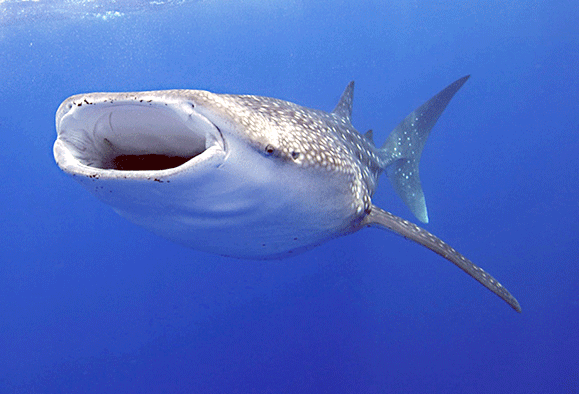Whale Shark
Common Name: Whale Shark
Scientific Name: Rhincodon typus

Description
The whale shark (Rhincodon typus) is the world's largest fish and is a harmless filter feeding shark. This species is closely related to the bottom-dwelling sharks, which include the wobbegong.
The whale shark has a mouth which can be up to 1.5 metres wide, a broad flat head and two small eyes located towards the front of the head. The body is mostly grey with a white belly. Three ridges run along the side of each animal and there are five large pairs of gills. The skin is marked with lots of spots and stripes. These spots are unique to each whale shark and because of this they can be used to identify each individual animal.
Range
The whale shark occurs in all of the world's tropical and warm-temperate oceans, usually between latitudes 30N and 35S, and is thought to prefer surface sea-water temperatures between 21 - 25C. Whale sharks are known to inhabit both deep and shallow coastal waters and the lagoons of coral atolls and reefs. Western Australia is one of the most reliable locations to find whale sharks in the world. From around mid-March to mid-May each year they are common in Ningaloo Marine Park. At times, in December and January, they have also been seen as far south as Shark Bay Marine Park and even Kalbarri. The sharks regularly appear at locations where seasonal food 'pulses' are known to occur, for instance, the mass spawning of coral triggers the arrival of whale sharks at Ningaloo Marine Park.
Natural History
The whale shark (Rhincodon typus) is a relatively recent addition to the human record of the ocean and its inhabitants. However, the ancestry of this shark goes back to the Jurassic and Cretaceous periods 245-65 million years ago, when the present groups of sharks began to appear.
It was not until 1828 when the first whale shark specimen known to science was discovered off the South African coast. Dr Andrew Smith formally described this species later that year as the largest living shark in the ocean.
This species is rare. Prior to the mid-1980's, there had been less than 350 confirmed reports of whale sharks worldwide. Since this time, consistent sightings have been recorded in Australia. A lucrative ecotourism industry revolving around their annual appearance at Ningaloo Marine Park (NMP) on the Western Australian northwest coast is now well established.
Biology and ecology
This species is closely related to the bottom-dwelling sharks (Orectolobiformes), which include the wobbegong. There is a pattern of lines and spots on the skin of each shark which enables them to 'blend' into their surroundings. This 'camouflage' makes the sharks less conspicuous in their oceanic environment. The unique patterning does not appear to change over time and can be used to identify individual sharks.
One of only three filter-feeding sharks (the other two being the basking and megamouth sharks), the whale shark feeds on minute organisms including krill, crab larvae, jellyfish etc. Although they have approximately 3000 tiny teeth (each less than 6mm in length), these teeth are not used while feeding. Instead, the whale shark can sieve prey items as small as 1mm through the fine mesh of the gill-rakers. They are able to open their mouth to a great width (greater than 1m) to optimise feeding.
Diet
The whale shark is one of only three filter-feeding sharks (the other two are the basking and megamouth sharks). It feeds on very small plankton including small crustaceans like krill, copepods and crab larvae as well other tiny invertebrates such as squid, small fish and jellyfish. Whale sharks have thousands of tiny teeth arranged in more than 300 rows but they neither bite nor chew their food.
Breeding
Whale sharks have internal fertilisation and produce live young. Males can be distinguished by the presence of two claspers near the pelvic fin. These organs are absent in females.
A long-term study has been undertaken at NMP since 1995 by Mr Brad Norman. This has established that male whale sharks do not usually mature before they reach a length of around 8-9m. The size at maturity of female whale sharks cannot, however, be determined through similar external observation.
It is, at present, not known where whale sharks breed. Only one pregnant whale shark has ever been recorded. There have been very few juvenile whale sharks seen at any location throughout their range.
Habitat
Whale sharks are fish, and therefore obtain oxygen via their gills. They have no physiological requirement to swim at the surface - unlike air-breathing whales and dolphins. Although they are most often observed swimming at the surface during 'seasonal' aggregations, evidence from tracking studies undertaken at NMP and at other international locations indicate that whale sharks can dive to great depths (~700m). They can remain away from the surface for long periods.
Although whale sharks are often sighted with numerous other fish - these gaining some protection from the larger whale shark - they invariably react when subject to physical contact. It is important for boats and swimmers not to impede the path of the sharks in any way.
 Deep Sea Crabs
Deep Sea Crabs